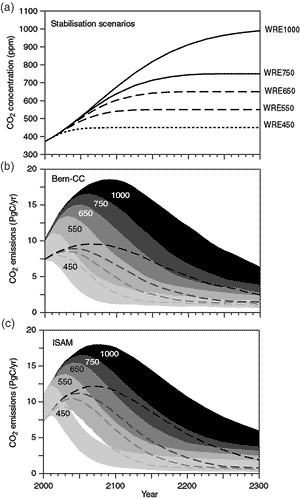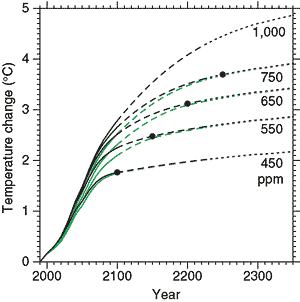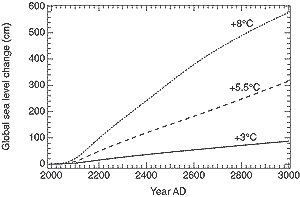
Figure 25: Projcted CO2 emissions permitting stabilisation
of atmospheric CO2 concentrations at different final values.
Panel (a) shows the assumed trajectories of CO2 concentration
(WRE scenarios) and panels (b) and (c) show the implied CO2
emissions, as projected with two fast carbon cycle models, Bern-CC and ISAM.
The model ranges for ISAM were obtained by tuning the model to approximate
the range of responses to CO2 and climate from model intercomparisons.
This approach yields a lower bound on uncertainties in the carbon cycle
response. The model ranges for Bern-CC were obtained by combining different
bounding assumptions about the behaviour of the CO2 fertilisation
effect, the response of heterotrophic respiration to temperature and the
turnover time of the ocean, thus approaching an upper bound on uncertainties
in the carbon cycle response. For each model, the upper and lower bounds
are indicated by the top and bottom of the shaded area. Alternatively, the
lower bound (where hidden) is indicated by a hatched line. [Based on Figure
3.13] |
F.10 Projections of Future Changes in Response to CO2 Concentration
Stabilisation Profiles
Greenhouse gases and aerosols
All of the stabilisation profiles studied require CO2 emissions
to eventually drop well below current levels. Anthropogenic CO2
emission rates that arrive at stable CO2 concentration levels from
450 to 1,000 ppm were deduced from the prescribed CO2 profiles (Figure
25a). The results (Figure 25b) are not substantially
different from those presented in the SAR; however, the range is larger, mainly
due to the range of future terrestrial carbon uptake caused by different assumptions
in the models. Stabilisation at 450, 650 or 1,000 ppm would require global anthropogenic
emissions to drop below 1990 levels within a few decades, about a century, or
about two centuries, respectively, and continue to steadily decrease thereafter.
Although there is sufficient uptake capacity in the ocean to incorporate 70
to 80% of foreseeable anthropogenic CO2 emissions to the atmosphere,
this process takes centuries due to the rate of ocean mixing. As a result, even
several centuries after emissions occurred, about a quarter of the increase
in concentration caused by these emissions is still present in the atmosphere.
To maintain constant CO2 concentration beyond 2300 requires emissions
to drop to match the rate of carbon sinks at that time. Natural land and ocean
sinks with the capacity to persist for hundreds or thousands of years are small
(<0.2 PgC/yr).
Temperature
Global mean temperature continues to increase for hundreds of years at a rate
of a few tenths of a degree per century after concentrations of CO2
have been stabilised, due to long time-scales in the ocean. The temperature
implications of CO2 concentration profiles leading to stabilisation
from 450 ppm to 1,000 ppm were studied using a simple climate model tuned to seven
AOGCMs with a mean climate sensitivity of 2.8°C. For all the pathways leading
to stabilisation, the climate system shows considerable warming during the 21st
century and beyond (see Figure 26). The lower the
level at which concentrations stabilise, the smaller the total temperature change.
Sea level
If greenhouse gas concentrations were stabilised (even at present levels),
sea level would nonetheless continue to rise for hundreds of years. After
500 years, sea level rise from thermal expansion may have reached only half of
its eventual level, which models suggest may lie within a range of 0.5 to 2.0
m and 1 to 4 m for CO2 levels of twice and four times pre-industrial,
respectively. The long time-scale is characteristic of the weak diffusion and
slow circulation processes that transport heat into the deep ocean.
The loss of a substantial fraction of the total glacier mass is likely.
Areas that are currently marginally glaciated are most likely to become ice-free.
Ice sheets will continue to react to climatic change during the next several
thousand years, even if the climate is stabilised. Together, the present
Antarctic and Greenland ice sheets contain enough water to raise sea level by
almost 70 m if they were to melt, so that only a small fractional change in
their volume would have a significant effect.
Models project that a local annual average warming of larger than 3°C,
sustained for millennia, would lead to virtually a complete melting of the Greenland
ice sheet with a reulting sea level rise of about 7 m. Projected temperatures
over Greenland are generally greater than globally averaged temperatures by
a factor of 1.2 to 3.1 for the range of models used in Chapter
11. For a warming over Greenland of 5.5°C, consistent with mid-range
stabilisation scenarios (see Figure 26), the Greenland
ice sheet is likely to contribute about 3 m in 1,000 years. For a warming of
8°C, the contribution is about 6 m, the ice sheet being largely eliminated.
For smaller warmings, the decay of the ice sheet would be substantially slower
(see Figure 27).
Current ice dynamic models project that the West Antarctic ice sheet (WAIS)
will contribute no more than 3 mm/yr to sea level rise over the next thousand
years, even if significant changes were to occur in the ice shelves. Such
results are strongly dependent on model assumptions regarding climate change
scenarios, ice dynamics and other factors. Apart from the possibility of an
internal ice dynamic instability, surface melting will affect the long-term
viability of the Antarctic ice sheet. For warmings of more than 10ºC, simple
runoff models predict that a zone of net mass loss would develop on the ice
sheet surface. Irreversible disintegration of the WAIS would result because
the WAIS cannot retreat to higher ground once its margins are subjected to surface
melting and begin to recede. Such a disintegration would take at least a few
millennia. Thresholds for total disintegration of the East Antarctic ice sheet
by surface melting involve warmings above 20ºC, a situation that has not
occurred for at least 15 million years and which is far more than predicted
by any scenario of climate change currently under consideration.

Figure 26: Simple model results: Projected global mean temperature
changes when the concentration of CO2 is stabilised following
the WRE profiles (see Chapter
9 Section
9.3.3). For comparison, results based on the S profiles in the
SAR are also shown in green (S1000 not available). The results are
the average produced by a simple climate model tuned to seven AOGCMs.
The baseline scenario is scenario A1B,
this is specified only to 2100. After 2100, the emissions of gases
other than CO2 are assumed to remain constant at their
A1B 2100 values. The projections are
labelled according to the level of CO2 stabilisation. The
broken lines after 2100 indicate increased uncertainty in the simple
climate model results beyond 2100. The black dots indicate the time
of CO2 stabilisation. The stabilisation year for the WRE1000
profile is 2375. [Based on Figure
9.16] |
|

Figure 27: Response of the Greenland ice sheet to three climatic
warming scenarios during the third millennium expressed in equivalent
changes of global sea level. The curve labels refer to the mean temperature
rise over Greenland by 3000 AD as predicted by two-dimensional climate
and ocean model forced by greenhouse gas concen-tration rises until
2130 AD and kept constant after that. Note that projected temperatures
over Greenland are generally greater globally averaged temperatures
by a factor of 1.2 to 3.1 for the models used in Chapter
11. [Based on Figure
11.16] |
|
|

